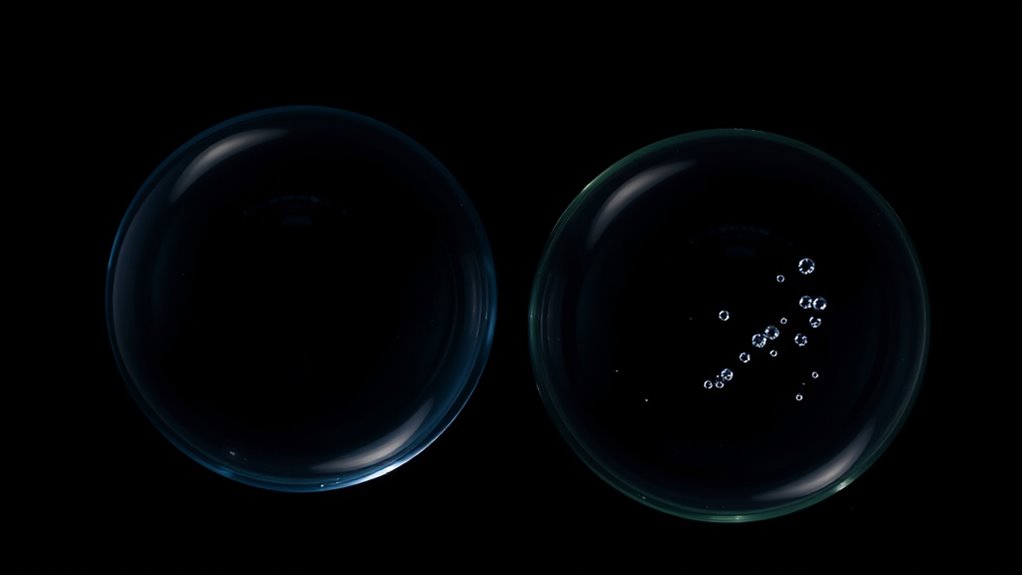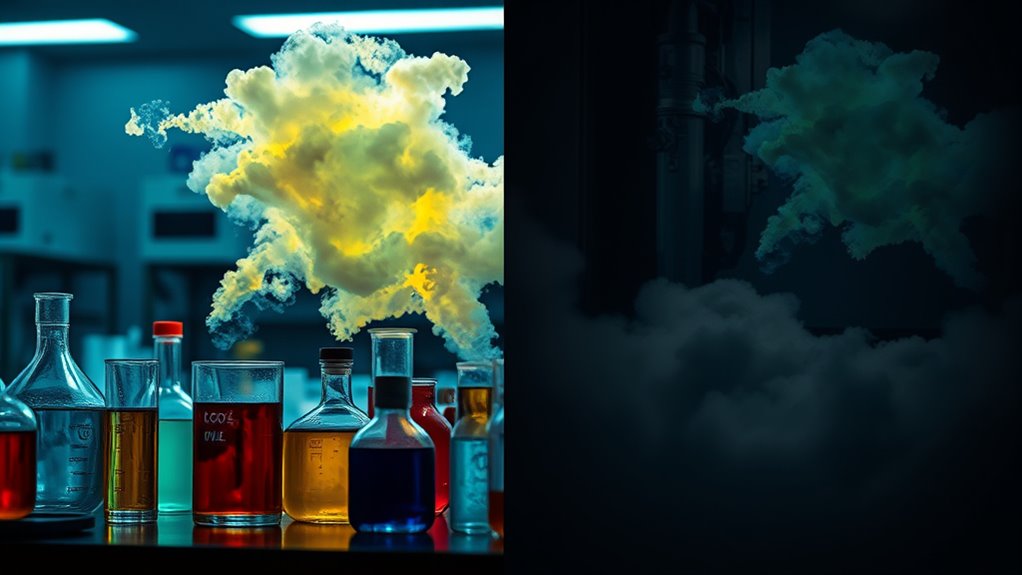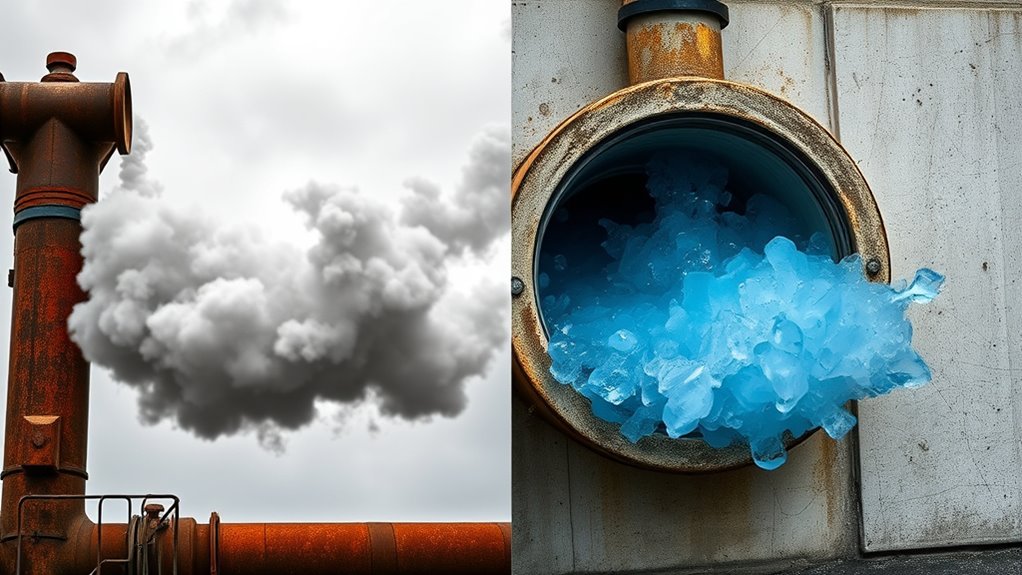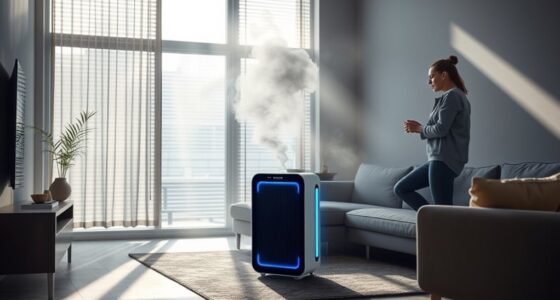Carbon monoxide (CO) and carbon dioxide (CO₂) are two gases with very different dangers. CO is a harmful, colorless, odorless gas that binds to your hemoglobin, reducing oxygen flow and risking serious health problems or death. CO₂, in contrast, is a natural byproduct of breathing and combustion; high levels cause headaches, fatigue, or disorientation. Knowing how each gas behaves and how to detect them helps you stay safe—discover more about these gases’ differences below.
Key Takeaways
- CO is a highly toxic, invisible gas that impairs oxygen transport, causing poisoning and potentially death.
- CO₂ is less toxic but can displace oxygen, leading to suffocation in high concentrations indoors.
- CO is lighter than air, tends to accumulate near ceilings, while CO₂ is heavier, settling near the ground.
- CO exposure causes symptoms like headaches and dizziness; CO₂ buildup causes CO₂-specific symptoms like confusion.
- Detection and emergency response differ: CO requires immediate ventilation and alarms; CO₂ management focuses on ventilation and plant absorption.
Understanding the Nature and Sources of CO and CO₂

Carbon monoxide (CO) and carbon dioxide (CO₂) are both colorless gases that originate from different sources and have distinct roles in the environment. You’ll find CO mainly produced during incomplete combustion of carbon-containing materials, like vehicle engines, wood fires, or faulty heating systems. CO results from chemical reactions where oxygen supply is limited, leading to incomplete oxidation. CO₂, on the other hand, forms when fuels burn completely, releasing it as a byproduct of combustion. Gas densities play a role in how these gases behave; CO is lighter than air, causing it to rise and accumulate near ceilings, while CO₂ is denser, settling closer to the ground. Self Watering Plant Pots can help reduce indoor humidity and improve air quality, indirectly impacting the presence of these gases. Understanding these differences helps you recognize their sources and how their chemical reactions influence their presence in various environments.
The Health Risks Associated With Carbon Monoxide

Because it binds tightly to hemoglobin in your blood, carbon monoxide poses serious health risks even at low levels. When inhaled, it reduces oxygen delivery to your tissues, leading to symptoms like headaches, dizziness, and fatigue. Prolonged exposure can cause unconsciousness or death. Poor air quality from faulty appliances or fires increases your risk. Quick emergency response is essential to prevent lasting damage. Additionally, high-quality projectors can help in monitoring and ensuring proper ventilation in indoor spaces. Here’s a table outlining common exposure levels:
| Level (ppm) | Symptoms | Action Needed |
|---|---|---|
| 0-9 | Normal air quality | No action needed |
| 10-35 | Mild headache | Ventilate area |
| 35-200 | Dizziness, nausea | Seek fresh air, emergency response |
| 200-400 | Confusion, unconsciousness | Immediate medical help |
| >400 | Life-threatening | Evacuate and call emergency services |
The Role of Carbon Dioxide in Indoor and Outdoor Environments

While carbon monoxide poses immediate health threats at high concentrations, understanding the role of carbon dioxide in our environments reveals a different set of concerns. In indoor spaces, increased CO₂ levels can affect air quality and comfort, especially with many indoor plants that absorb CO₂ during photosynthesis, helping improve ventilation. Outside, CO₂ is a major greenhouse gas contributing to climate change and pollution effects. Elevated outdoor CO₂ levels influence plant growth and can intensify global warming. Although CO₂ isn’t an immediate toxin, its buildup impacts ecosystems, weather patterns, and air quality. Recognizing its role helps you understand how indoor plants can help mitigate CO₂, while reducing outdoor pollution effects can slow climate change. This awareness underscores the importance of managing CO₂ in both indoor and outdoor environments. Understanding greenhouse gases is essential for appreciating their effects on our planet’s climate.
Detecting and Monitoring Carbon Monoxide and Carbon Dioxide Levels

You need reliable detection devices to keep track of carbon monoxide and carbon dioxide levels in your environment. Monitoring safety levels helps you recognize when concentrations guarantee dangerous, reducing health risks. Being aware of symptoms and understanding risks ensures you respond quickly to potential hazards. Utilizing advanced sensors can improve detection accuracy and provide real-time alerts, enhancing overall safety through automation in business intelligence.
Detection Technologies and Devices
Detecting and monitoring carbon monoxide (CO) and carbon dioxide (CO₂) levels rely on advanced sensors and devices designed for accuracy and reliability. In industrial applications, these sensors help prevent dangerous buildup, ensuring worker safety and operational efficiency. For environmental impact, monitoring devices track emission levels, aiding in pollution control and climate change mitigation. CO detectors often use electrochemical or metal oxide sensors for quick, precise readings, while CO₂ sensors commonly employ infrared technology for continuous monitoring. These detection tools enable you to assess potential hazards promptly, minimizing risks associated with toxic exposure or excessive greenhouse gases. Accurate detection is essential for maintaining safety standards, protecting ecosystems, and complying with regulations, making these technologies essential in both industrial settings and environmental management efforts.
Monitoring Safety Levels
Monitoring safety levels of carbon monoxide (CO) and carbon dioxide (CO₂) involves continuously tracking their concentrations to prevent health hazards and guarantee compliance with safety standards. In industrial applications, real-time sensors help detect dangerous gas build-ups, ensuring worker safety and operational efficiency. Accurate monitoring also minimizes environmental impacts by preventing emissions from exceeding permitted levels. You should use reliable detection devices, such as electronic sensors and monitoring systems, to maintain consistent oversight. Regular calibration and data logging are essential for effective management. Additionally, understanding air quality monitoring techniques can help optimize safety protocols and ensure timely responses to any detected anomalies. By staying vigilant, you reduce risks associated with toxic exposure and environmental damage, safeguarding both human health and ecosystems. Consistent monitoring is key to managing these gases responsibly across various settings.
Recognizing Symptoms and Risks
Since both carbon monoxide and carbon dioxide can pose serious health risks at high levels, recognizing their symptoms and understanding the risks is crucial for safety. Awareness helps you act quickly to prevent poisoning. Symptoms of carbon monoxide poisoning include headache, dizziness, nausea, and confusion, while high carbon dioxide levels can cause shortness of breath, rapid breathing, and fatigue. To guarantee fire safety and proper ventilation practices, regularly monitor indoor air quality. You should also:
- Use detectors for both gases in key areas
- Maintain good ventilation, especially in enclosed spaces
- Recognize early symptoms to seek immediate help
- Keep appliances well-maintained to prevent leaks
- Educate yourself on gas exposure risks and safety measures
Early detection can save lives, so stay vigilant and prioritize proper ventilation.
Prevention Strategies for CO Poisoning and CO₂ Accumulation

To prevent carbon monoxide (CO) poisoning and CO₂ buildup, you should prioritize installing proper ventilation and safety devices in your home. Use effective ventilation techniques like exhaust fans and open windows during cooking or heating to reduce gas accumulation. Additionally, install carbon monoxide detectors and CO₂ monitors on every level for early warning. Ensure regular maintenance of fuel-burning appliances to prevent leaks. In emergencies, act swiftly by evacuating the premises and calling emergency response services. Keep these safety measures in mind:
| Safety Measure | Purpose |
|---|---|
| Proper ventilation techniques | Reduce gas buildup |
| Install detectors | Early warning of danger |
| Emergency response plan | Minimize health risks |
Implementing proper ventilation can significantly decrease the risk of dangerous gas concentrations in your home.
Why Recognizing the Differences Matters for Safety

Understanding the differences between carbon monoxide (CO) and carbon dioxide (CO₂) is essential for your safety because each gas poses unique health risks and requires specific precautions. Recognizing these distinctions helps you respond effectively during emergencies and follow regulatory standards properly. Misidentifying CO as CO₂ could delay critical actions, increasing danger. Knowing the significance of bank swiftifs codes and their proper use can also enhance your overall safety protocols in various contexts.
- Know the signs of CO poisoning vs. CO₂ buildup
- Follow proper emergency procedures tailored to each gas
- Use appropriate detection devices for accurate identification
- Comply with regulatory standards to prevent exposure
- Educate yourself on safe ventilation and maintenance practices
Frequently Asked Questions
How Do CO and CO₂ Affect the Environment Differently?
You should know that CO and CO₂ affect the environment differently. CO, or carbon monoxide, mainly contributes to urban pollution, harming air quality and posing health risks. CO₂, or carbon dioxide, considerably impacts the climate by trapping heat in the atmosphere, leading to global warming. While CO is a direct pollutant, CO₂’s long-term climate impact makes it a major concern for environmental health and sustainability.
Are There Specific Industries More at Risk From CO or CO₂?
Imagine walking into a factory’s smoky haze—that’s where you’ll find industries most at risk from CO or CO₂. Welding shops, engine rooms, and chemical plants face higher danger from CO due to incomplete combustion. Meanwhile, cement and steel industries emit more CO₂. Strict workplace safety measures and emission regulations help protect workers and the environment, but understanding each gas’s risks guarantees you stay safe and compliant.
Can Co₂ Be Used Safely in Medical or Industrial Applications?
You can use CO₂ safely in medical and industrial applications if you follow proper safe handling procedures and adhere to regulatory standards. In medical settings, CO₂ is used for insufflation during procedures, while in industry it’s employed for carbonation and cooling. Ensuring proper ventilation, storage, and training minimizes risks. Always stay updated on safety guidelines to prevent accidents, making sure its use remains safe for workers and patients alike.
What Are the Long-Term Health Effects of Low-Level CO Exposure?
Chronic exposure to low-level CO can cause concerning cognitive and neurological impacts. Over time, you might experience headaches, dizziness, and difficulty concentrating. Prolonged exposure can subtly strain your nervous system, leading to lasting neurological effects. Staying vigilant and ventilating your environment reduces risks. Regular monitoring and minimizing exposure help protect your health, preventing the persistent, pervasive problems associated with long-term contact with this silent, hazardous gas.
How Do Weather COnditions Influence CO and CO₂ COncentrations?
Weather conditions substantially influence CO and CO₂ levels. Poor air circulation traps these gases, causing concentrations to rise, especially in enclosed spaces. Temperature fluctuations can increase emissions from sources like vehicles or heating systems, leading to higher indoor and outdoor levels. When it’s cold or still, gases don’t disperse well, so you might notice elevated risks. Staying aware of these conditions helps you better manage exposure and guarantee safer air quality.
Conclusion
While carbon monoxide silently threatens your life with its deadly, invisible presence, carbon dioxide quietly affects your environment and comfort. Recognizing their differences helps you stay safe—preventing poisoning from CO and avoiding suffocation or discomfort from CO₂ buildup. Don’t ignore the dangers lurking in your home or outdoors. By understanding these gases, you empower yourself to detect risks early and take action—because safety depends on knowing what to look for in both danger and opportunity.









